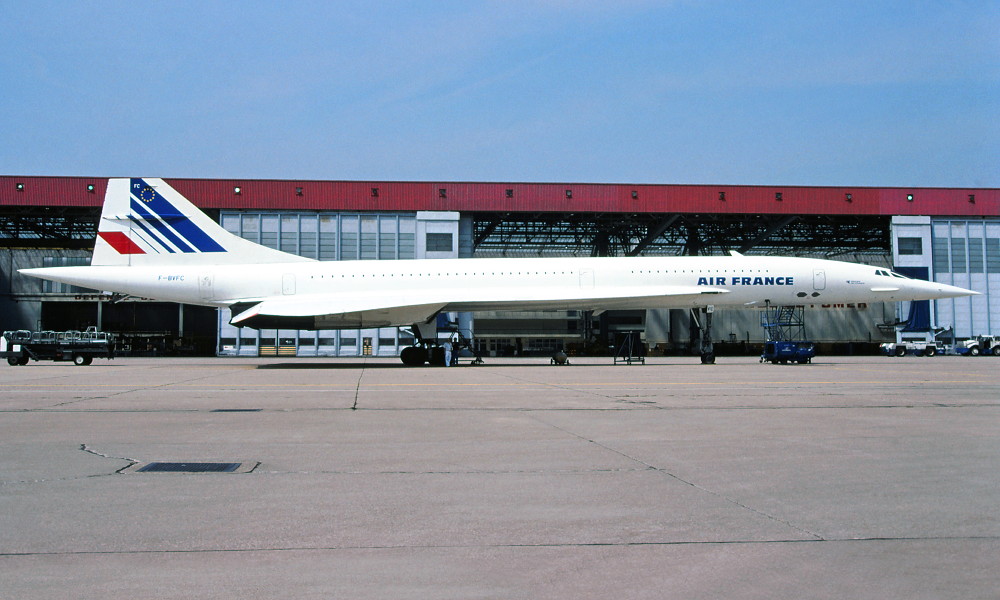F-BVFC. Aerospatiale Concorde 101. c/n 209.
This aircraft was built by built by Societe Nationale Industrielle Aerospatiale, (Aerospatiale), Toulouse, France. It was entered onto the French Aircraft Register as F-BVFC and registered to Aerospatiale. It flew for the time from Toulouse on July 9, 1976. Registered to Compagnie Nationale Air France on July 28, 1976 it was handed over to the airline the following month on August 3. It was re-registered F-BVFC / N94FC to Air France / Braniff Airways on January 1, 1979 to comply with American registration requirements for the operation of the aircraft across continental United States. Following the aircraft's arrival at New York / Washington DC from Paris, the aircraft was used by Braniff Airways to fly its Washington DC - Dallas Fort Worth service and return. Use of this aircraft was short-lived on the route as it was reregistered F-BVFC on June 1, 1980. F-BVFC undertook a 'round-the-world trip' from September 6 - 28 1989, travelling some 51,354 kms in 37 hours and 25 minutes of flying, of which 19 hours 17 minutess was flown at supersonic speed. A second 'round-the-world trip' was operated from October 10 - 26, 1993, travelling some 43,084 kms in 35 hours 20 minutes of flying, of which 17 hours 5 minutes was flown at supersonic speed. F-BVFC was withdrawn from service to undergo a 'D' check from March 1997 to May 1998. As a result of the crash of the Air France Concorde at Charles de Gaulle Airport, Paris on July 25, 2000 Air France grounded all of its Concordes immediately. F-BVFC found itself marooned in New York following the grounding order and remained there for 3 months before being ferried back to Paris on September 21, 2000. As F-BVFC's Certificate of Airworthiness had been cancelled on August 15, 2000 the flight would have had to receive special clearance. It was fitted with the 'return to flight' modifications that had been mandated by the aircraft's manufacturer and the relevant airworthiness authorities. The tyre manufacturer Michelin announced on June 7, 2001 that the tyres that were tested at Istres on the French Concorde F-BTSD would be fitted to all Concordes when they returned to service. On September 5, 2001 Certificates of Airworthiness were returned to modified Concordes by the British CAA and French DGAC. The CAA and DGAC announced that once each Concorde had been modified, its Certificate of Airworthiness would also be returned. F-BVFC carried out its last ever flight on June 27, 2003. The aircraft departed Paris CDG Airport at approximately 11:30 am and flew out over the Atlantic Ocean for a final supersonic sprint, before heading overland subsonically to the former Aerospatiale factory at Toulouse. Over 30,000 people from the area surrounding Toulouse turned out to see the aircraft arrive. Everyone from the Airbus plant was allowed to line up along the airport taxiway to watch the arrival of the jet, without which Airbus would not have been as successful as it is now in the global aircraft production industry. The aircraft, crewed by Commander Henri-Gilles Fournier, Co-pilot Eric Tonnot and Flight Engineer Daniel Casari, overflew the airport in a go-around maneuver before circling round and landing for the last-ever time. The crew took the aircraft on a tour of the taxiways of Toulouse to show off Concorde to the gathered crowds for one final time before taxing to the Airbus factory. After the aircraft had taxied off the main airport apron she was towed the final few hundred meters to be parked outside the very same hangar that Concorde had been officially rolled out from in 1967, nearly four decades ago. Inside the famous hangar, over 1000 specially invited guests were present for the handing-over ceremony, that would officially see the aircraft being signed over to Airbus from the national carrier. After the aircraft was parked, the VIPs disembarked, with the biggest cheer of the day being reserved for André Turcat when he emerged from the aircraft. André Turcat was the pilot who in March 1969 took Concorde into the air for the very first time. He, along with his British counterpart, the late Brian Trubshaw, were pivotal in planning and implementing the flight test programmes that would eventually lead to the certification of the aircraft in late 1975. The technical crew of this last flight of F-BVFC were: Captain Henri Gilles Fournier - first Concorde flight on April 2, 1997 - 1460 hours flying on Concord; First Officer Eric Tonnot - first Concorde flight on March 25, 2000 - 400 hours flying on Concorde; Flight Engineer Daniel Casari - 380 hours flying on Concorde. The cabin crew in the final flight were: Christine Badia-Hebras - joined Air France in 1990 - 8520 hours of flight including 330 hours on Concorde; Catherine Pellerin - joined Air France in 1978 - cabin instructor on Concorde; Martine Pelisson - joined Air France in 1978; Franck Touati - joined Air France in 1984; Alain deBroise - joined Air France in 1989; Sandrine Pichot - joined Air France in 1989 - had accumulated 6,772 hours of flight including 1,176 hours on Concorde. F-BVFC was cancelled from the French Aircraft Register on June 2, 2003. At the time of its retirement F-BVFC had flown a total of 14,332 hours with 4,358 cycles. It had flown 4,200 supersonic cycles. |
 |
F-BVFC. Air France - in the old livery with additional 'Institut Weizmann des Sciences' titles at an unknown airport, August 1990. (R. N. Smith Collection Copyright Image 1926-020.) |
 |
F-BVFC. Air France - in the old livery at Paris Orly Airport, July 1994. (C.Laugier Copyright Image 1926-021.) |